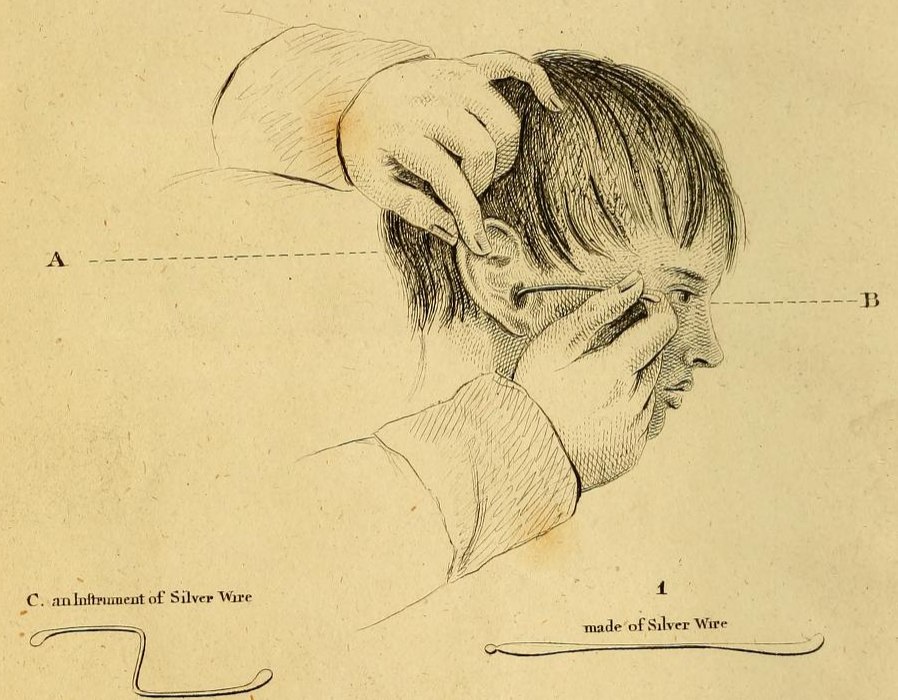Aloud Poetry

Illustration from William Wright’s ((1773–1860)) book, An Essay on the Human Ear, published London, in 1817
Earlier this year I stayed the night with some friends and, settling into a beer and an armchair, I listened to a performance put on for me by two of their kids, both under the age of six. They perfectly recited from memory poems by George Herbert, Robert Frost, and Mark Strand, pausing for rhetorical emphasis and pandering dramatically to their audience. I’ll admit that a part of me felt jealous that no one had ever taught me poems—only stories, songs, and prayers—when I was small, but I overwhelmingly felt awed by the children’s performance, how this family had made poetry a part of their life together, their home.
The longer I’ve lived my life with poetry, the more I desire to hear it aloud, experience it aloud. Now, when I read poetry collections, I often catch myself murmuring the poems when I think I’m silently reading, no matter if I’m in public or alone, and other times I indulge my desire to hear the poem by reading it aloud to my dog. (I censor out the words “walk,” “eat,” and “out,” however, else I get his hopes up.) It also means that I increasingly desire good reading performances from poets, even find myself bitter at lackluster and monotone readings, at “poet voice” and its attendant pendulum swings between apathy and taking-oneself-too-seriously. I find myself downloading podcasts of readings, casting around for those cadences that will live in me, over which I can improv my own songs. My whole writing process has changed because of this. Now I often start my drafts by speaking aloud the words, allowing the poems to come to me, to live on my mouth, on my tongue, before they ever make it to the page.
Lucille Clifton also drafted her poems aloud too. Matthew G. Kirschenbaum notes in Track Changes: A Literary History of Word Processing that she would write and revise the poems aloud before typing up the final draft on her VideoWriter, an old school word processing unit she used for over a decade. Can we not hear this in her poems, in their mouthfeel and bottled breath? Here’s her poem “Blessing the Boats”:
Blessing the Boats
(at St. Mary’s)
may the tide
that is entering even now
the lip of our understanding
carry you out
beyond the face of fear
may you kiss
the wind then turn from it
certain that it will
love your back may you
open your eyes to water
water waving forever
and may you in your innocence
sail through this to that
The lines here are sculpted by the qualification of the breath onto the sentence’s meaning, how the tide both enters into a physical space—a bay, the harbor—and also figuratively into “the lip of our understanding.” The form of the blessing, a benediction, is one meant to be said aloud, and in giving its blessing, the poem relies upon the way spoken sentence unfold. It maintains a sense that the language is getting away from the speaker slightly, that the poem is leading the poet rather than the other way around.
Gerard Manley Hopkins, Victorian era poet and Jesuit priest, set out to invent a type of poetry that imitated the natural cadences of the spoken word, and he named this form “sprung rhythm.” In A Poet’s Glossary, Edward Hirsch says that sprung rhythm “is a particular method of timing….Hopkins objected to the way that in most post-Renaissance English poetry a stressed syllable is accompanied by a uniform number of unstressed ones. He thought this was musically deadening.” Here’s the opening of Hopkins’s “The Blessed Virgin Compared to the Air We Breathe”:
Wild air, world-mothering air,
Nestling me everywhere,
That each eyelash or hair
Girdles; goes home betwixt
The fleeciest, frailest-fixed
Snowflake; that’s fairly mixed
With, riddles, and is rife
In every least thing’s life;
This needful, never spent,
And nursing element;
My more than meat and drink,
My meal at every wink;
This air, which, by life’s law
My lung must draw and draw
Deeply influenced by the Welsh alliterative style of cynghanedd, Hopkins drew upon its structure of consonant chimes (for an example, see “fleeciest, frailest-fixed / Snowflake; that’s fairly mixed,” as well as the copious amounts of assonance and consonantal slant rhymes between the k of “Snowflake” and x of “fixed” and “mixed”) and while these highly stylized sonic patterns don’t necessarily feel quite natural as conversational speech, its system of stresses at the beginning of the poem’s metrical feet is meant to “reflect the dynamic quality and variations of common speech,” according to the Poetry Foundation’s Poetic Terms Glossary.
Compare Hopkins’s sprung rhythm to the work of one of my favorite readers, Ross Gay. Here’s the opening of his poem “To a Fig Tree on 9th and Christian,” which incidentally hangs in my living room, as a cloth broadside created by the author:
Tumbling through the
city in my
mind without once
looking up
the racket in
the lugwork probably
rehearsing some
stupid thing I
said or did
some crime or
other the city they
say is a lonely
place until yes
the sound of sweeping
and a woman
yes with a
broom beneath
which you are now
too the canopy
of a fig its
arms pulling the
September sun to it
This poem seems to be made for the voice, its breathless lunges, its unfolding syntax. The poem is made for the voice the way a piece of music is specified for an instrument. It seems then that the argument is that the poem is arranged for the page, the way a piece of music can be rearranged for another instrument.
For so long, I’ve heard academic poets and readers disparage poems written to be spoken aloud, condemning them as less thoughtful, as noisy and navel-gazey, their craft less delicate and considered. Because I’m no expert on spoken word or slam poetry, I won’t go into their craft here, but I’d like to suggest that all of our poems should be both for the page and for the voice, the book and the public reading, in much the same way that Sol Lewitt’s conceptual art is hung in its direction form and as the executed artwork. Additionally, the poem aloud may hit more ears than the poem on the page, as evidenced by the increasing popularity and relevance of programs like Poetry Out Loud, which “encourages students to learn about great poetry through memorization and recitation. This program helps students master public speaking skills, build self-confidence, and learn about literary history and contemporary life.” As a previous judge at two Virginia high schools and a guest at that state’s POL finals in 2015, I saw how poetry arrived to students, became a part of them as “They recite poems they / have carried in their mouths for days,” as Tarfia Faizullah writes in “Poetry Recitation at St. Catherine’s School for Girls.” For the sake of poetry, we should support its reliance upon the voice, no matter the medium.
With this in mind, I’ll leave you with a quote from a Gwendolyn Brooks interview about the power of poetry reading, posted by a friend on social media just as I was writing this:
Well, right across the street is a tavern, and one Sunday afternoon, some of the poets decided to go in there and read poetry to just whoever was there. I went with them. One of them went to the front of the tavern and said, “Say, folks, we’re going to lay some poetry on you.” And there had been a couple of fights in there, people drinking, and all kinds of exciting things going on; and some of us wondered how they were going to respond to poetry. But the poets started reading their poetry, and before we knew it, people had turned around on their bar stools, with their drinks behind them, and were listening. Then they applauded. And I thought that was a wonderful thing, something new to me. I want to write poetry—and it won’t be Ezra Pound poetry, as you can imagine—that will be exciting to such people. And I don’t see why it can’t be “good” poetry, putting quotes around “good.”



